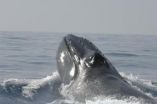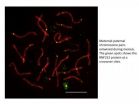(Press-News.org) Scientists from Stanford University, the Wildlife Conservation Society, the American Museum of Natural History, and other organizations are closing in on the answer to an important conservation question: how many humpback whales once existed in the North Atlantic?
Building on previous genetic analyses to estimate the pre-whaling population of North Atlantic humpback whales, the research team has found that humpbacks used to exist in numbers of more than 100,000 individuals. The new, more accurate estimate is lower than previously calculated but still two to three times higher than pre-whaling estimates based on catch data from whaling records.
Known for its distinctively long pectoral fins, acrobatics, and haunting songs, the humpback whale occurs in all the world's oceans. Current estimates for humpback whale numbers are widely debated, but some have called for the level of their international protection to be dropped.
The study appears in the recently published edition of Conservation Genetics. The authors include: Kristen Ruegg and Stephen Palumbi of Stanford University; Howard C. Rosenbaum of the Wildlife Conservation Society and the American Museum of Natural History; Eric C. Anderson of the National Marine Fisheries Service and University of California-Santa Cruz; Marcia Engel of the Instituto Baleia Jubarte/Humpback Whale Institute, Brazil; Anna Rothschild of AMNH's Sackler Institute for Comparative Genomics; and C. Scott Baker of Oregon State University.
"We're certain that humpback whales in the North Atlantic have significantly recovered from commercial whaling over the past several decades of protection, but without an accurate size estimate of the pre-whaling population, the threshold of recovery remains unknown," said Dr. Kristen Ruegg of Stanford University and the lead author of the study. "We now have a solid, genetically generated estimate upon which future work on this important issue can be based."
"Our current challenge is to explain the remaining discrepancy between the historical catch data and the population estimate generated by genetic analyses," said Dr. Howard Rosenbaum, study co-author and Director of the Wildlife Conservation Society's Ocean Giants Program. "The gap highlights the need for continued evaluations of whale populations, and presents new information informing the debate and challenges associated with recovery goals."
"We have spent a great deal of effort refining the techniques and approaches that give us this pre-whaling number," said Dr. Steve Palumbi of Stanford. "It's worth the trouble because genetic tools give one of the only glimpses into the past we have for whales."
Reaching some 50 feet in length, the humpback whale was hunted for centuries by commercial whaling fleets in all the world's oceans. Humpbacks had predictable migration routes and were reduced to several hundred whales in the North Atlantic. The global population was reduced by possibly 90 percent of its original size. The species received protection from the International Whaling Commission in North Atlantic waters in 1955 due to the severity of its decline.
Since that time, the humpback whales of the North Atlantic have made a remarkable comeback; experts estimate the current size of the North Atlantic's humpback whale population to be more than 17,000 animals. North Atlantic humpback whales are now one of the best-studied populations of great whales in the world and the mainstay of a multi-million dollar whale-watching industry.
But estimating the number of whales that existed prior to commercial whaling is a far more difficult problem, critical in determining when the total population has recovered. Historical catch data from the logs of whaling vessels suggest a population size between 20,000-46,000 whales, but the current genetic analysis indicates a much larger pre-whaling population. The results of the genetic analysis indicate that the North Atlantic once held between 45,000—235,000 humpback whales (with an average estimate of 112,000 animals).
A previous study using the mitochondrial DNA of humpbacks in the North Atlantic suggested a higher pre-whaling population size; an average of 240,000 individuals. To increase the accuracy of the current analysis, the team measured nine segments in the DNA sequences throughout the genome (as opposed to just one DNA segment used in the previous study).
Palumbi, who participated in the first humpback genetic analysis, added: "The International Whaling Commission reviewed the results of the first study and recommended we improve the method in six specific ways. We've done that now and have the best-ever estimate of ancient humpback populations."
Scott Baker, Associate Director of Oregon State University's Marine Mammal Institute and a co-author said: "These genetic estimates greatly improve our understanding of the genetic diversity of humpback whales, something we need to understand the impact of past hunting and to manage whales in the uncertain future."
The research team analyzed genetic samples from whales in the North Atlantic as well as the Southern Hemisphere. Southern Atlantic whales were used to answer one of the six IWC questions: was there intermixing of whale populations across the equator? The samples were analyzed by sequencing specific regions of DNA in known genes. By comparing the genetic diversity of today's population to the genetic mutation rate, Ruegg and colleagues could estimate the long-term population size of humpbacks. They also showed no substantial migration of humpbacks whales across the Equator between the Southern and Northern Atlantic, and no movement from the Pacific to the Atlantic.
The team recently used the same techniques to estimate pre-whaling numbers for the Pacific gray whale and the Antarctic minke whale. A difference of two to three times also was recorded between the genetic and catch estimates for the grey whale population, but were exactly on target for the Antarctic minke whale, which has not been extensively hunted.
INFORMATION:
This work was supported by a grant from the Lenfest Ocean Program.
Genetic study pursues elusive goal: How many humpbacks existed before whaling?
North Atlantic humpbacks have come back but accurate pre-whaling estimate is key to defining recovery
2013-02-14
ELSE PRESS RELEASES FROM THIS DATE:
Robots with lift
2013-02-14
They can already stand, walk, wriggle under obstacles, and change colors. Now researchers are adding a new skill to the soft robot arsenal: jumping.
Using small explosions produced by a mix of methane and oxygen, researchers at Harvard have designed a soft robot that can leap as much as a foot in the air. That ability to jump could one day prove critical in allowing the robots to avoid obstacles during search and rescue operations. The research is described in a Feb. 6 paper in the international edition of Angewandte Chemie.
"Initially, our soft robot systems used pneumatic ...
Study supports regulation of hospitals
2013-02-14
EAST LANSING, Mich. — Hospital beds tend to get used simply because they're available – not necessarily because they're needed, according to a first-of-its-kind study that supports continued regulation of new hospitals.
Michigan State University researchers examined all 1.1 million admissions at Michigan's 169 acute-care hospitals in 2010 and found a strong correlation between bed availability and use, even when accounting for myriad factors that may lead to hospitalization. These factors include nature of the ailment, health insurance coverage, access to primary care ...
Clues to chromosome crossovers
2013-02-14
Neil Hunter's laboratory in the UC Davis College of Biological Sciences has placed another piece in the puzzle of how sexual reproduction shuffles genes while making sure sperm and eggs get the right number of chromosomes.
The basis of sexual reproduction is that a fertilized egg gets half its chromosomes from each parent — sperm and eggs each contributing one partner in each pair of chromosomes. We humans have 23 pairs of 46 chromosomes: so our sperm or eggs have 23 chromosomes each.
Before we get to the sex part, though, those sperm and eggs have to be formed from ...
Preventing obesity transmission during pregnancy
2013-02-14
A much neglected part of the obesity epidemic is that it has resulted in more overweight/obese women before and during pregnancy. Their offspring also tend to have higher birth weights and more body fat, and carry an increased risk of obesity and chronic diseases later in life. However, the nutritional factors and mechanisms involved pre and during pregnancy that may influence child obesity remain uncertain. A recent publication by ILSI Europe identifies and discusses key contributing factors leading to obesity.
In an article recently published in Annals of Nutrition and ...
Probiotic-derived treatment offers new hope for premature babies
2013-02-14
BETHESDA, Md. (Feb. 13, 2013)—"Good" bacteria that live in our intestines have been linked with a variety of health benefits, from fighting disease to preventing obesity. In a new study, Kriston Ganguli of Massachusetts General Hospital for Children and Harvard Medical School and her colleagues have discovered another advantage to these friendly microscopic tenants: Chemicals secreted by good bacteria that typically live in the intestines of babies could reduce the frequency and severity of a common and often-lethal disease of premature infants.
This disease, known as ...
Marsh plants actively engineer their landscape
2013-02-14
DURHAM, NC -- Marsh plants, far from being passive wallflowers, are "secret gardeners" that actively engineer their landscape to increase their species' odds of survival, says a team of scientists from Duke University and the University of Padova in Italy.
Scientists have long believed that the distribution of plants within a marsh is a passive adaption in which species grow at different elevations because that's where conditions like soil aeration and salinity best meet their needs.
But this team found intertidal marsh plants in Italy's famed Venetian lagoon were ...
Cellular renewal process may underlie benefits of omega fatty acids
2013-02-14
A search for genes that change their levels of expression in response to nutrient deprivation has uncovered potential clues to the mechanism underlying the health benefits of omega fatty acids. In the Feb. 15 issue of Genes & Development, Massachusetts General Hospital (MGH) researchers describe finding that feeding omega-6 fatty acids to C. elegans roundworms or adding them to cultured human cells activates a cellular renewal process called autophagy, which may be deficient in several important diseases of aging. A process by which defective or worn-out cellular components ...
Vanderbilt study reveals clues to childhood respiratory virus
2013-02-14
New Vanderbilt-led research published in the Feb. 14 issue of the New England Journal of Medicine has identified the relatively unknown human metapneumovirus (MPV) as the second most common cause of severe bronchiolitis in young children.
Senior author John Williams , M.D., associate professor of Pediatric Infectious Diseases and a well-known expert in MPV research, said it is gratifying to offer a clearer picture of how this virus impacts children.
"We found MPV is as important a cause of respiratory illness as influenza, and caused more illness than the three common ...
Rewiring the serotonin system
2013-02-14
An interdisciplinary team of researchers from the University of Texas Medical Branch at Galveston and the University of Houston has found a new way to influence the vital serotonin signaling system — possibly leading to more effective medications with fewer side effects.
Scientists have linked malfunctions in serotonin signaling to a wide range of health issues, everything from depression and addictions to epilepsy and obesity and eating disorders. Much of their attention has focused on complex proteins called serotonin receptors, which are located in the cell membrane. ...
Light-emitting bioprobe fits in a single cell
2013-02-14
If engineers at Stanford have their way, biological research may soon be transformed by a new class of light-emitting probes small enough to be injected into individual cells without harm to the host. Welcome to biophotonics, a discipline at the confluence of engineering, biology and medicine in which light-based devices – lasers and light-emitting diodes (LEDs) – are opening up new avenues in the study and influence of living cells.
The team described their probe in a paper published online February 13 by the journal Nano Letters. It is the first study to demonstrate ...
LAST 30 PRESS RELEASES:
The impact of family dynamics on eating behaviour – how going home for Christmas can change how you eat
Tracing the quick synthesis of an industrially important catalyst
New software sheds light on cancer’s hidden genetic networks
UT Health San Antonio awarded $3 million in CPRIT grants to bolster cancer research and prevention efforts in South Texas
Third symposium spotlights global challenge of new contaminants in China’s fight against pollution
From straw to soil harmony: International team reveals how biochar supercharges carbon-smart farming
Myeloma: How AI is redrawing the map of cancer care
Manhattan E. Charurat, Ph.D., MHS invested as the Homer and Martha Gudelsky Distinguished Professor in Medicine at the University of Maryland School of Medicine
Insilico Medicine’s Pharma.AI Q4 Winter Launch Recap: Revolutionizing drug discovery with cutting-edge AI innovations, accelerating the path to pharmaceutical superintelligence
Nanoplastics have diet-dependent impacts on digestive system health
Brain neuron death occurs throughout life and increases with age, a natural human protein drug may halt neuron death in Alzheimer’s disease
SPIE and CLP announce the recipients of the 2025 Advanced Photonics Young Innovator Award
Lessons from the Caldor Fire’s Christmas Valley ‘Miracle’
Ant societies rose by trading individual protection for collective power
Research reveals how ancient viral DNA shapes early embryonic development
A molecular gatekeeper that controls protein synthesis
New ‘cloaking device’ concept to shield sensitive tech from magnetic fields
Researchers show impact of mountain building and climate change on alpine biodiversity
Study models the transition from Neanderthals to modern humans in Europe
University of Phoenix College of Doctoral Studies releases white paper on AI-driven skilling to reduce burnout and restore worker autonomy
AIs fail at the game of visual “telephone”
The levers for a sustainable food system
Potential changes in US homelessness by ending federal support for housing first programs
Vulnerability of large language models to prompt injection when providing medical advice
Researchers develop new system for high-energy-density, long-life, multi-electron transfer bromine-based flow batteries
Ending federal support for housing first programs could increase U.S. homelessness by 5% in one year, new JAMA study finds
New research uncovers molecular ‘safety switch’ shielding cancers from immune attack
Bacteria resisting viral infection can still sink carbon to ocean floor
Younger biological age may increase depression risk in older women during COVID-19
Bharat Innovates 2026 National Basecamp Showcases India’s Most Promising Deep-Tech Ventures
[Press-News.org] Genetic study pursues elusive goal: How many humpbacks existed before whaling?North Atlantic humpbacks have come back but accurate pre-whaling estimate is key to defining recovery




